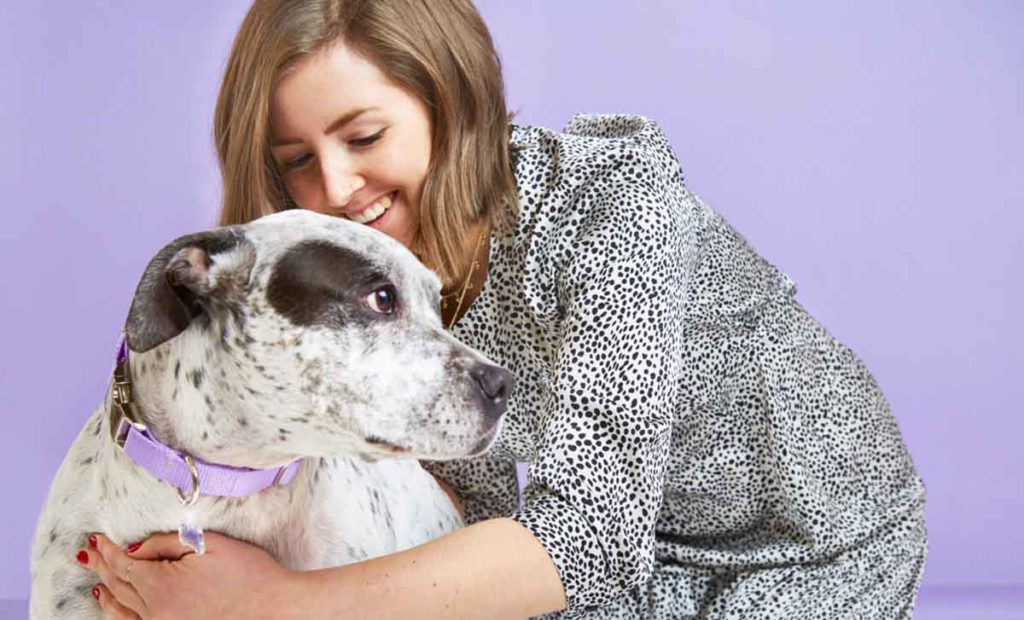Is your older dog walking around a familiar home looking lost, confused, or otherwise disoriented? Do they stay up into the night and sleep all day, or isolate themselves when they used to be very sociable? These are symptoms of Canine Cognitive Dysfunction (CCD). Some cognitive dexterity can normally diminish with age in dogs as in humans; however, dogs presenting symptoms of CCD are not aging normally.
Do you think your canine companion may have CCD? It is crucial to speak with your veterinarian to rule out other medical conditions and develop a management plan. A decline in older dogs’ physical or mental health can be a challenge for pet parents who are impacted by their dogs’ cognitive and behavioral changes. However, your dog can live a happy, healthy life with an effective management strategy.
Table of contents
What is Canine Cognitive Dysfunction (CCD)?
Dogs, like humans, may develop neurodegenerative conditions like Alzheimer’s, which impact cognitive function, including memory, learning, perception, and awareness capabilities. Senior dogs are at risk of Canine Cognitive Dysfunction (CCD), also referred to as Cognitive Dysfunction Syndrome (CDS), which is characterized by progressive neurodegenerative changes in the cerebral cortex and hippocampus, with clinically expressed behavioral changes that are not attributable to other medical conditions.
The estimated prevalence rates of CCD range from 14% to 35% in the pet dog population, dramatically increasing as dog’s age. It is unclear to what extent the pet population is affected by CDS. This is partly due to the high degree of variability in how dogs age and the lack of systematic CDS evaluation criteria. With advances in veterinary medicine and improved owner care, dogs live longer and have increased the incidence of CCD, with as many as 85 percent of cases going undiagnosed.
Several studies of dog cognitive decline focus on translational approaches to human Alzheimer’s, using the dog to model human aging. Several histopathologic similarities exist between human brains affected by Alzheimer’s disease and dog brains affected with CCD. While the dog proves to be a good model with similar neuropathy to humans, the study of canine cognitive decline is important in its own right.
Is cognitive decline inevitable with aging – and what is the difference between normal canine aging and CCD?
How is CCD different from Normal Cognitive Aging?
In dogs, the diversity of physical and breed-related features means that aging can impact individuals differently. Old age also comes with a higher prevalence of various pathological conditions, and to diagnose a dog with CCD, one must exclude medical causes associated with similar conditions. Further, CCD is usually diagnosed using behavioral criteria – and the sensory impairments common to canine aging often have a profound and confounding influence on behavior.
The clinical distinction between normal dogs and dogs with pathological mental decline often relies on whether the dog shows impairment across multiple categories or just one. Diagnostic questionnaires and thresholds vary – therefore, these distinctions can be subjective. Significant brain pathological changes have also been detected through MRIs to quantify brain atrophy in cognitively impaired dogs.
The impairments with CCD are more severe than those seen with normal aging processes or cognitive decline, despite some overlap of behavioral signs with the latter. Unlike the typical signs of aging – hearing and vision loss or a general slowing down – CDD often involves a problem with thought processing and a change in physiology.
What Are The Symptoms of CCD?
The general signs pet parents should look out for are represented with the acronym DISHA.
DISHA: disorientation, a decrease in social interactions, changes in sleep-wake cycles, a loss of prior housetraining, increased anxiety, and changes in their level of activity
- Disorientation: appearing lost or confused in familiar surroundings. Your dog may also experience difficulty with spatial awareness. If your dog seems disoriented, the first thing you should do is take him to the vet, as you want to rule out other medical issues like a brain tumor or diabetes.
- Interactions: Your once sociable pup may experience a change in attitude. This could be a result of a painful medical condition and not necessarily CCD.
- Sleep-Wake Cycles: A change in sleep patterns or disruption in circadian rhythms is a symptom more specific to CCD. Your canine companion being up all night can be frustrating for both of you. There are strategies you can employ for trying to get your pup to go to sleep, like eliminating distractions with a quiet room or white noise, as well as talking to your veterinarian about ways to ease your pup’s anxiety.
- House Soiling: If your pup was previously house-trained, this is one of the most common ways cognitive dysfunction is detected in dogs. This is because your pup may have lost his ability to control elimination voluntarily. After running tests and ruling out a bladder infection or diabetes, your pup may have undergone a cognitive change. They may not have difficulty controlling their bladder; instead, they do not understand that it is to be controlled.
- Activity Level Changes / Anxiety: Dogs with cognitive dysfunction may show a decreased desire to explore and a decreased response to things, people, and sounds in their environments.
Besides the DISHA criteria, researchers detected a substantial cognitive decline in tests measuring spatial learning and memory in dogs with CCD. Additionally, CCD dogs are reported to display erratic locomotion patterns, an increased frequency of aimless behaviors, and changes in social responsiveness, such as decreased response to social isolation and human interaction.
It is important to remember that many of these symptoms indicate a medical condition other than cognitive decline, so make sure to visit your vet!
How Can I Help My Dog?
The exact cause of CCD is unknown; therefore, it is difficult to determine exactly how to prevent dementia in dogs. Keeping your dog physically and mentally active will help to prevent dementia. There is no known cure for CCD – the condition leads to the physical deterioration of the brain, and therefore, there is no simple corrective measure that can regenerate these tissues. However, there are management strategies to employ to enable your dog to live happily and healthily.
Effective Management of CCD May Involve
- Environmental and Behavioral Interventions: Make resources more easily accessible, and understand that older dogs may require more opportunities for elimination, either outdoors or in an indoor elimination area. Increase exercise and reduce disturbances in the evening. Behavioral modification is similar to approaches used for younger pets, but with some limitations – adjusting behavior signals if sensory dysfunction is significant. Maintaining a routine can reduce anxiety and help regular mental stimulation to maintain cognitive functioning.
- Dietary Modification / Nutritional Supplements: antioxidants, medium-chain triglycerides, SAMe, Phosphatidylserine
- Pharmaceutical Treatments: MAO inhibitors result in increased phenylethylamine levels, increased dopamine release, and decreased free radical formation.
- Complementary Therapies: treating any anxiety-related conditions, whether it be through pharmacological intervention or other therapies, will significantly increase your pup’s quality of life.
Bottom Line
If you suspect your senior dog is cognitively impaired, make an appointment with your veterinarian to ensure no confounding medical conditions and devise the best management plan through lifestyle modifications and enrichment. Together with your vet, you can enable your older pet to live a happy, healthy, comfortable life.











